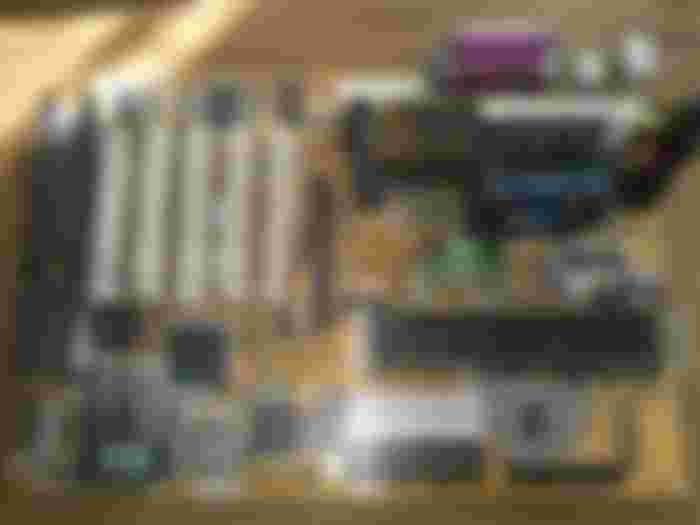Overview of the Slot-1/Socket 370 motherboards
Nowadays, motherboards are designed to be compatible with only one generation of processors. After one or two generation, manufacturers are switching to another processor sockets. Back then, this was different. Older motherboards not just supported multiple generations of CPU, but also supported processors of multiple CPU manufacturers. In previous articles, i have already reviewed the Socket 5/7 platform, which is compatible with the designs of 5 CPU manufacturers and multiple processor generations. I have made reviews from some of the motherboards here already, this time i will explain the architecture details of this socket. Beyond technical details, i will also share my personal experience with these processors.

What made this possible
A modern processor has the memory controller, the disk controller, the graphics, and the IO integrated into the chip itself. That was not always the case. Older architectures had separate chip on the motherboard for everything - even the memory handler circuit was built onto the motherboard. The processor itself was only able to handle arithmetical and logical operations, the rest of the functionality was handled by the motherboard chipset. This resulted processor sockets to have longer life spans, and multiple generations of chips were released to the same socket, before they have changed it to something more modern.
Why this is changed
If the system requires multiple chips, the power consumption can not be decreased below a certain range. Multiple chips have a cost increasing factor as well. If multiple chip is required to implement basic functionality, then some functions becoming slower due to the more complex and longer traces, such as the memory management itself. As the technology got more modern enough, manufacturers were able to integrate more and more functionality to the processor itself. In this review, i will go backwards, and i will feature the laters multi-vendor platforms at first, and then go backwards to the older architectures.
Socket 370/Slot-1
The latest and newest multi-vendor processor platform is the Socket370/Slot-1 architecture. The Socket 370 and Slot-1 are quite different form factor for the first glimpse, but actually it is the same design below the hood. The Slot 1 was originally introduced in 1996, alongside with the new Intel Pentium 2 processor. The Slot-1 processors are shaped as a cartridge. They contain the cooling, the cartridge has the chip itself soldered on, and depending on the model, they have external cache memory chips soldered on the cartridge as well.

Picture: An early Slot-1 motherboard with integrated RAID controller.
The first generations of the Slot-1
The Intel Pentium 2 appeared on the market in 1996, it was intended to be a high-end solution to replace the older Pentium1 (Socket4/5/7) based processors. The Pentium2 is significantly faster than the original Pentium and Pentium MMX due to its modern superscalar design. The Pentium2 was very expensive. The slowest model was the 233 MHz unit. Within two years, Intel have reached 400 MHz with the architecture. Intel decided to release low-end versions of the Pentium2 in 1998, called the Celeron. The Celeron was also using the Slot-1 design, as the older pre-Socket-1 designs slowly becoming obsolete. The Celeron processors began at 266 and 300 MHz, originally they lacked L2 cache memory, but it was easy to overclock them.
The performance of the first Slot-1 Celeron
The first generation of Slot-1 Celerons were about 30% slower than the Pentium2 on the same clock. The performance of the Celeron 266 was about equal to a Pentium1 233 or an AMD K6 at 266 MHz under office type of usage, however the Celeron processors were faster under video games by about 30% compared to the Socket7 systems. The Celeron was a good overclocker, the 266 MHz Celeron processor were able to reach between 350 to 400 MHz, which made them to be a very viable product, especially for playing games.
Slot-1 is getting adapted to accept Pentium Pro
The Pentium Pro was a server processor architecture, using the Socket8 platform. However, that architecture were aging, so a converter, called Slotket, was released. This converter were plugging into Slot-1 on the motherboard, and it was possible to insert Socket8 Pentium Pro processors into this converter, making it possible to use the old Socket8 based Pentium Pro processors in Socket-1 motherboards.
The arrive of the Socket 370
Intel have decided to port the Celerons to a traditional socket form factor, because that is more cheap. The Socket 370 processors are internally more or less identical to their Slot-1 counterparts. Socket 370 processors can be plugged into Slot-1 motherboards with a Slotket as well. Originally, Socket 370 was only meant to house Celerons, but manufacturers had different idea - some started putting both Socket 370 and Slot-1 processor connectors to the motherboards, allowing both type of CPU to be used (but not simultaneously, only one at one time).

picture: a Socket370 to Slot-1 Slotket adapter, and a 400 MHz Intel Celeron
These type of Celeron processors were released with 128 KByte internal L2 cache in the end of 1998, and their cores were still more or less based on the Pentium2 processors. They scaled from 333 MHz to 533 MHz. The 533 MHz model was released in 2000. The most popular version was the 400 MHz modell. Most of the slower Celerons can be clocked to about 500 MHz or even above.

picture: ECS P6BAT-A+ REV 2.2
I have bought the motherboard on this picture in late 2003 as my main PC. It has a Slot-1 and a Socket 370 connector as well. I have used it for less than a year, but it was a good experience after the previous Socket7 based motherboards i had. I got a 400 MHz Celeron processor with it. It was in a shed for more than a decade, till it got re-discovered. The motherboard got a Pentium3 last year, which works in it, surprisingly. This year i have succesfully upgraded it with more memory, so now, a total of 384 MByte memory is installed in it. (Actually, more, but it can only detect regular 256 MByte modules as 128 MByte instead). With the new memory modules i have installed, i can run the 700 MHz Pentium3 processor at 780 MHz with 112 MHz FSB. As it was mentioned in a previous test, the Pentium3 is a lot faster than the Celeron, retrospectively of course the Celeron was also able to run most of the Win9x based games more or less properly, if proper drivers were used.
The Pentium3
Intel have released the Pentium III in 1999. Initially, the Pentium3 processors were released to Slot-1 only. Most of the early Slot-1 based Pentium2/Celeron motherboards were compatible with the new Pentium3 line of processors as well, but there were some exceptions. The first Slot-1 based Pentium3 processors (code named Katmai) had external L2 cache memory chips on the cartridge, similarly to the Pentium2 processors. A significant difference was the 100 MHz system bus and the new SSE instruction set extension. Previously, all the Pentium2 and Celeron processors used 66 MHz system bus. This bus was limiting the performance in memory-intensive programs, so the 100 MHz system bus gave a little bit of extra performance for the higher clocked Pentium3 processors compared to the Pentium2. The initial Pentium3 processor was released on 450 MHz clock, and it wasnt notably faster than the identical Pentium2 processor. The highest clocked Pentium 3 processor of the Katmai architecture was released at 600 MHz. These processors were not good overclockers, most early motherboards didn't supported FSB above 100 MHz so there was no chance of overclocking. If both the memory, both the motherboard supported FSB speeds above 100 MHz, usually only 20 or 30 MHz overclock was possible. Despite this, some iterations of these processors were even released with 133 MHz FSB.
The new generation of Pentium 3
The second Pentium3 line was codenamed Coppermine, and they were released at the end of 1999. These processors now had the cache memory integrated into the CPU core itself. The Coppermine was released for both the Slot-1 and for the Socket 370. Some Socket 370 boards supported them after a bios upgrade, some doesnt. Slot-1 owners, who wanted to use these processors in their computers, required a new Slotket adapter. Coppermine processors from 500 MHz to 1033 MHz was released, but the 600 and 700 MHz models were the most frequently available models. Some had an FSB of 100 MHz, others had 133 MHz FSB. The most popular models of the Coppermine was the 600 and 700 MHz versions, using the 100 MHz FSB. It was easy to find them, and it was easy to overclock them to around 766-800 MHz, if the motherboard supported overclocking. The performance of the system was able to scale linearly to this clock speed, even with low-end motherboards, and these new Pentium3 processors was about two times faster than the 450 MHz Pentium2 and Pentium3 processors. New Celerons were released based on the Pentium3, for the Socket 370, with decreased L2 memory size, from 533 MHz to 1.1 GHz. Cheaper and older Socket 370 motherboards usually not supporting faster than 750 MHz processors, so these higher clocked Pentium3 Coppermine processors were not as popular as the lower clocked models.

VIA Cyrix3
VIA bought Cyrix, and Centaur design from IDT in 2000. Both Cyrix and Centaur originally designed processors for the Socket7 platform, but they were preparing to release processors for the Socket 370 as well. The first VIA Cyrix3 processor was based on the design of Cyrix, and had the code name Joshua. The processor was not able to scale above 466 MHz, and mass manufacturing were not started. Most of the Cyrix3 models using the Cyrix design are engineering samples. VIA quickly decided to use the design of Centaur, code named Samuel, which was able to scale to 800 MHz. Models using the 100 and 133 MHz FSB were available. The processor was renamed to VIA C3 in 2001. The processor was created to compete with the Celeron.
VIA C3
The C3 (Samuel) originally had its floating point unit running half of the CPU speed. They got fixed this with the new Samuel2 core, the processor have also received 64 KByte L2 cache. These processors were created to compete with the Pentium3 based Celerons, the performance of a 800 MHz second generation VIA C3 processor approximately equals to a 600 MHz Celeron, or to a 500 MHz Pentium3 processor. VIA upgraded the C3 first with Ezra core, and later on with the Nehemiah architecture, which have removed the 3dnow! compatibility as well, and they have added SSE instead. In 2003, VIA decided to solder the processors onboard, instead of using a socket, and discontinued using the Socket 370 platform.
The new Intel Pentium3 core: Tualatin
Intel decided to upgrade the Pentium3 architecture once more again. The new Tualatin core was designed to compete against the processors of AMD, and Intel had the Pentium4 not yet finished. The Tualatin based Pentium3 processors are not backwards compatible with the older Socket370 motherboards. There are some Slotket adapters able to work with Tualatin based processors, but they were rare and expensive, so the Tualatin never gained notable attention from the market. Tualatin based Pentium3 processors have bigger L2 cache, more advanced instruction prefetch units, and they use 133 MHz FSB. The fastest Tualatin is the 1.4 GHz model. Celerons was also released from this architecture. No Slot-1 based Tualatin models were released.
Compatibility
The Socket 370 and/or Slot-1 boards are good for running Windows 9x, peroid correct programs and video games. When its equipped with a Pentium3, Windows XP can also ran on them without any issues. Socket 370 and Slot-1 motherboards usually have ISA ports as well, so DOS games can be run well, with genuine ISA sound cards. A carefully chosen Socket 370/Slot-1 can cover 90s era of gaming up to games released even in early 2000's, especially after a little bit of overclocking is used. These boards are available for $10 or so on second hand shops, so its very affordable for a retro budget gaming system.
Summary
The Socket 370/Slot-1 architecture is one of the last motherboard architectures supporting more than one CPU vendors. It supports Intel and VIA processors. Supports the Pentium2, the Pentium2 based Celeron processors. It usually supports the first and second generation of Pentium3 processors, and Pentium3 based Celerons. It supports the first few generations of VIA Cyrix3 and C3 based processors, some also support Pentium Pro processors with an adapter, and they can support Pentium3 based Intel Xeon processors. The supported processor frequencies are scaling from 233 MHz to 1 GHz, or even up to 1.4 GHz with motherboards capable to handle faster Tualatin processors.




